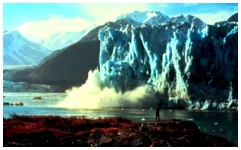
 It's Calving Season! "Tidewater" glaciers are valley glaciers that end in sea, lake, or river water. As the ice enters the water, it begins to float, and this action causes pieces to break off and float away. This is more pronounced in coastal ocean areas where the tides also do their part to separate ice from the glacier. When the glacier loses material in the water, it is called "calving", and tidewater glaciers are responsible for creating the icebergs, bergy bits and growlers that float in the water. As the ice breaks away from the glacier face, it often makes a loud cracking or booming sound. Calving happens quickly and usually without warning - so don't take your boat too close to a tidewater glacier! Photographers take note: If you've heard the "boom" and start to look around, you're already too late to get a photograph.
Click pictures for more information and credits. Library: Ice, Icebergs, Glaciers Links: Glaciers, Icebergs Maps: Arctic Maps & Weather Reports Source of Icebergs ) |

|
DICTIONARY: Just "double-click" any unlinked word on this page for the definition from Merriam-Webster's Student Electronic Dictionary at Word Central. |

|
ARCTIC LIBRARY & GLOSSARY: Check this section for an index of the rest of the things you really need to know about the Arctic. |

|
ARCTIC MAPS & WEATHER REPORTS: Maps of the Northwest Passage, explorers' routes, iceberg sources, Nunavut, the Arctic by treeline, temperature... |

|
ARCTIC LINKS: Even more information! Links to sites related to the Arctic and "Iceberg: the Story of the Throps and the Squallhoots". |

|
GUIDE TO ARCTIC SUNRISE & SUNSET: How much sunlight or darkness is there in the Arctic on each day of the year? |
to is the property of their respective owners, and Athropolis is not responsible for their content.